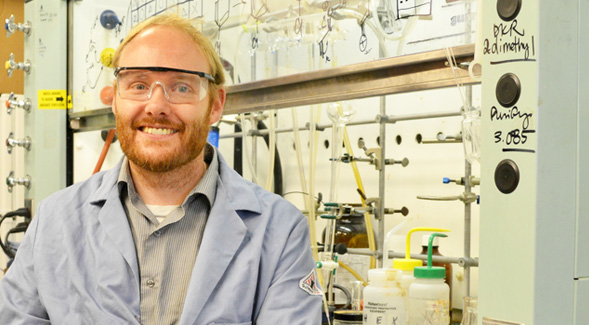Grant Writing Fellowship Spurs Early Success
SDSUs GREW program has helped pave the way to research funding for many early career scholars.

When San Diego State University chemistry professor Jeffrey Gustafson received a $400,000 research award from the National Science Foundation (NSF), the grant officer who approved his proposal highlighted the strong faculty mentorship programs at SDSU as a boon to the institution.“The goal of GREW is to create a recipe that early-career faculty can follow, and that builds on their own capabilities as experts in their fields.”
Not long before, Gustafson completed an SDSU fellowship aimed at improving the success of faculty research proposals to major funding organizations like NSF and the National Institutes of Health (NIH). He credits the lessons he learned as a fellow with helping him obtain the grant.
The Grants Research and Enterprise Writing (GREW) fellowship has taught nearly 90 early-career faculty members how to communicate effectively with grant officers, develop successful proposals and share their research with media and other stakeholders.
Since GREW began in 2014, fellows have netted nearly $20 million in grants. Of the more than 400 submissions reviewed by agencies, 43 percent have met with approval—a higher-than-average success rate.
Applying for research funding is a highly competitive process. The NIH, for example, approves fewer than 20 percent of proposals annually. New faculty are often not aware of all the factors that go into a successful proposal, and researchers without a lot of experience can find the application and submission process difficult.
“The process is overwhelming and confusing, but it is learnable,” said John Crockett, senior director of research advancement at SDSU. “The goal of GREW is to create a recipe that early-career faculty can follow, and that builds on their own capabilities as experts in their fields.”
The GREW program tutors faculty on how to write effective funding requests, but it doesn’t stop there. It teaches them how to communicate and pitch themselves to a variety of audiences; how to research funding opportunities; and how to build relationships with collaborators and influential program officers that direct agency funding. Fellows receive a $3,000 stipend and several have participated in trips to Washington, D.C. to visit major funding organizations and meet grant officers face-to-face.
“Writing a grant is about a lot more than writing a grant,” said Gustafson, who has received $2.3 million in research funding since participating in GREW in 2014. “It’s an entire endeavor, and GREW really hits that home.”
Byron Purse, an assistant professor of chemistry, says he undervalued communication prior to his GREW fellowship. Now he seeks out relationships with grant officers. The conversations that result help him narrow down which agencies and programs to apply to and determine the best way to craft his proposals.
“Part of grant writing is being efficient because we all have a limited amount of time available and constructing proposals is a huge effort,” Purse said, “so we learned how to have the right conversations with the right people to increase the odds of funding.”
Purse has received two grants from the NSF totaling $535,000 since he participated in GREW in 2015.
“What GREW really stresses is that you have to be more outgoing when pursuing funding,” explained Gustafson, who added that his doctoral studies fully prepared him to be a good scientist, but didn’t really teach him how to execute an effective funding proposal.
“I now vigorously go to as many conferences as I can with my time,” he continued. “Odds are there will be people who are reviewing grants there. As long as they see me out there, see me doing good science, in a couple of years from now when they review my grants, they’ll have a positive image of me.”



